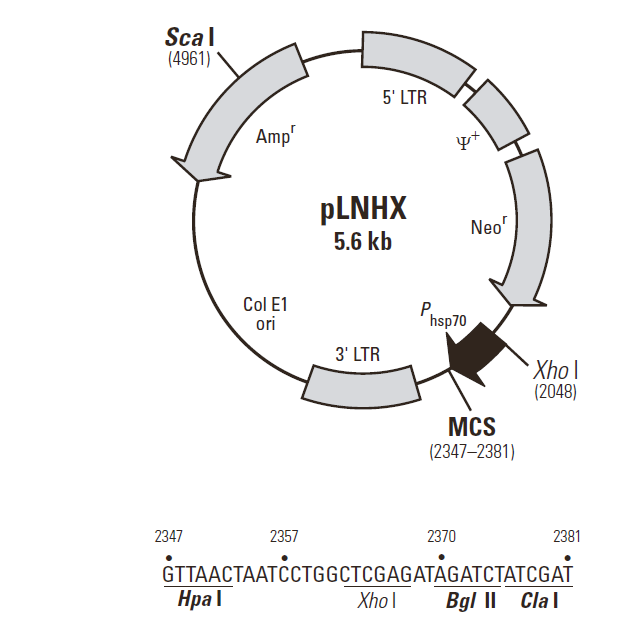pLNHX 载体
| 质粒类型: | 逆转录病毒载体 |
|---|---|
| 启动子: | hsp70 |
| 载体大小: | 5.6kb |
| 载体抗性: | Ampicillin (氨苄青霉素) |
| 筛选标记: | Neo (新霉素) |
pLNHX contains elements derived from Moloney murine leukemia virus (MoMuLV) and Moloney murine sarcoma virus (MoMuSV), and is designed for retroviral gene delivery and expression (1–4). Upon transfection into a packaging cell line, pLNHX can transiently express, or integrate and stably express, a transcript containing the viral packaging signal Ψ+, the neomycin selection marker (Neor), and a target gene. The 5' viral LTR in this vector contains promoter/enhancer sequences that control expression of the Neor gene, which allows antibiotic selection in eukaryotic cells. A target gene can be cloned into the multiple cloning site downstream of the Drosophila heat shock protein 70 (hsp70) promoter (Phsp70). pLNHX also includes the Col E1 origin of replication and E. coli Ampr gene for propagation and antibiotic selection in bacteria.
载体应用
As part of the Pantropic Retroviral Expression System (Cat. No. 631512), pLNHX can be cotransfected with pVSV-G into the GP-293 Packaging Cell Line (5) to produce infectious, replication- incompetent retrovirus. pLNHX does not contain the structural genes necessary for viral particle formation and replication. The genes encoding the viral gag and pol proteins are stably integrated into GP-293. Because the VSV-G envelope protein is toxic, this protein is expressed transiently from pVSV-G (5). Although the virus can infect target cell lines and transmit a target gene, it cannot replicate because the target cell lines lack the viral structural genes. By using the minimal viral sequences and separately introducing the structural genes into the packaging cell line, the chance of producing replication-competent virus due to recombination events is minimized. Alternatively, virus can be produced by transfecting pLNHX into either RetroPack PT67 (Cat. No. 631510) or EcoPack-293cells (#C3200-1). Note, these packaging cell lines stably express the MoMuLV envelope and thus, do not require pVSV-G.


